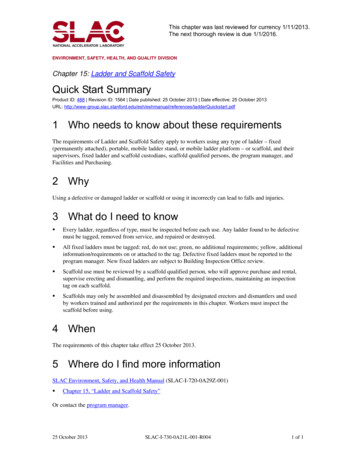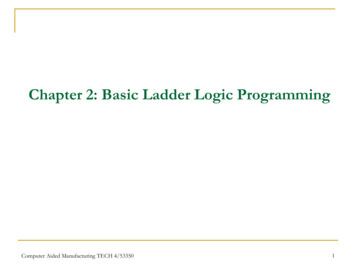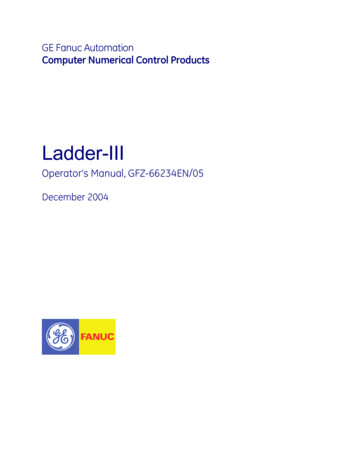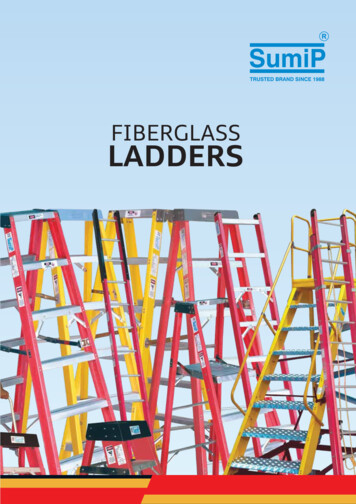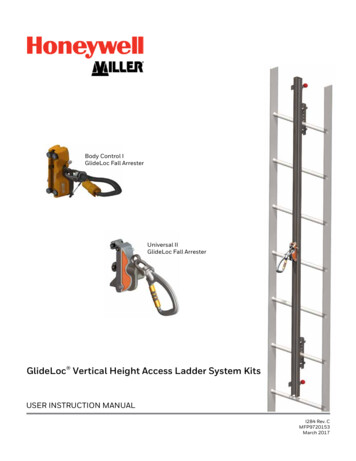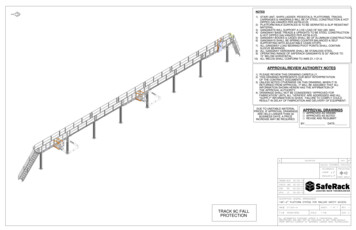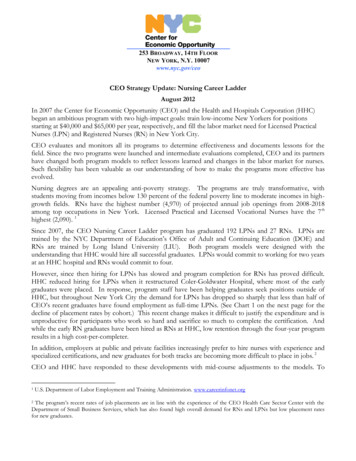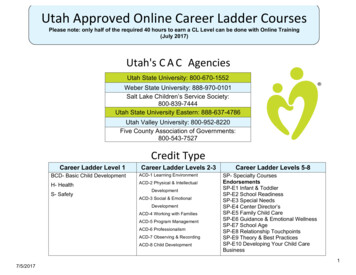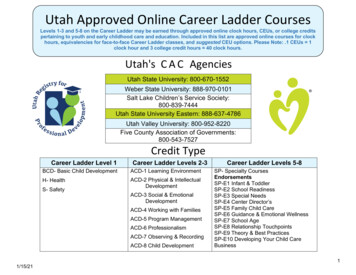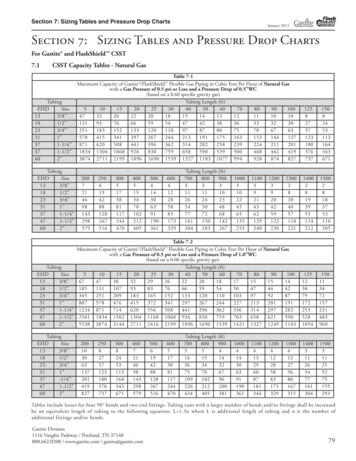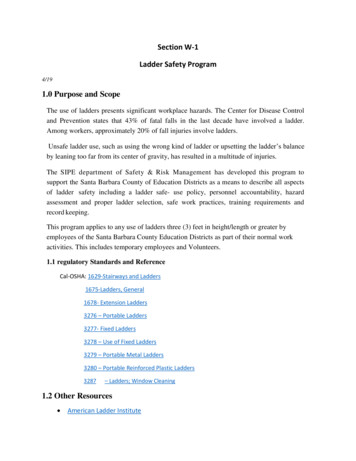
Transcription
Section W-1Ladder Safety Program4/191.0 Purpose and ScopeThe use of ladders presents significant workplace hazards. The Center for Disease Controland Prevention states that 43% of fatal falls in the last decade have involved a ladder.Among workers, approximately 20% of fall injuries involve ladders.Unsafe ladder use, such as using the wrong kind of ladder or upsetting the ladder’s balanceby leaning too far from its center of gravity, has resulted in a multitude of injuries.The SIPE department of Safety & Risk Management has developed this program tosupport the Santa Barbara County of Education Districts as a means to describe all aspectsof ladder safety including a ladder safe- use policy, personnel accountability, hazardassessment and proper ladder selection, safe work practices, training requirements andrecord keeping.This program applies to any use of ladders three (3) feet in height/length or greater byemployees of the Santa Barbara County Education Districts as part of their normal workactivities. This includes temporary employees and Volunteers.1.1 regulatory Standards and ReferenceCal-OSHA: 1629-Stairways and Ladders1675-Ladders, General1678- Extension Ladders3276 – Portable Ladders3277- Fixed Ladders3278 – Use of Fixed Ladders3279 – Portable Metal Ladders3280 – Portable Reinforced Plastic Ladders3287– Ladders; Window Cleaning1.2 Other Resources American Ladder Institute
2.0Administrative Duties & Responsibilities2.1 Santa Barbara County Education Office The ultimate responsibility for establishing and maintaining effective policies regardingenvironmental health and safety issues specific to Santa Barbara County School districtsfacilities and operations, rests with the Superintendents of each school district. Generalpolicies which govern activities and responsibilities under the Injury and Illness PreventionProgram are thereby established under the County of Santa Barbara Education Office/SIPESafety.Because of the wide diversity of operations within the Santa Barbara County Schools and thenecessary differences in organizational structure within various departments, it is recognizedthat certain responsibilities and expressed procedures in this program cannot be equallyapplied. There are, therefore, some details which might be impossible or impractical for onedepartment chair or department head to implement as directed while another would have nodifficulty in applying these procedures to everyone. Departments will, therefore, have somelatitude in formulating and implementing alternative methods when necessary, as long as thetotal Injury and Illness Prevention Program objectives are not compromised. The SantaBarbara County Education office/SIPE Safety and Risk Management will provide assistanceto campus departments seeking to implement alternate procedures.2.2 Santa Barbara County Education Office/SIPE SafetyIt is the responsibility of SIPE to develop, maintain, and administer oversite ofthe Injury and Illness Prevention Program. Further responsibilities are outlinedbelow: Develop, implement and maintain the Ladder Safety Program.Provide consultation to Department Supervisors, Directors, Chairpersons, andCoordinators regarding program compliance, including but not limited to issues ofhazard identification and evaluation, procedures for correcting unsafe conditions,systems for communicating with employees, holding regularly scheduled safetymeetings, providing employee training programs, regulatory compliance strategies,and recordkeeping.Provide centralized monitoring of county education districts-wide activities, on aconsultative basis, in the areas of safety, chemical hygiene, emergency preparedness,fire safety, hazard communication, hazard identification, hazardous materials
management, industrial hygiene, occupational safety, pest management, public healthand sanitation, risk management, and safety education and training.Maintain centralized environmental and employee monitoring records, allowingemployee access as directed by law.May provide training and periodic audits to assist Districts and their departments inLadder Safety Program complianceDevelops and maintains the Ladder Safety Program and makes it available to allemployees upon request.Collaborates with districts to determine risk potential when using ladders.Assists departments in training, selecting materials, and developing complianceguidelines.Periodically evaluates the Program to determine the effectiveness of the Program andupdates as necessary.2.3 Superintendents, Directors, Department Chairs, Department HeadsIt is the responsibility of Superintendents, Directors, Department Chairs and Department Headsto develop departmental procedures to ensure effective compliance with the Injury and IllnessPrevention Program and other SIPE health and safety policies as they relate to operationsunder their control. Specific areas include employee and student education and training,identification and correction of unsafe conditions, and recordkeeping.Specifically, these individuals will: Develop or adopt written departmental procedures and ensure that each supervisoradheres to adopted procedures.Develop or adopt and implement an education and training program designed to instructemployees and students in general safe work practices as well as instructions specificto their job duties. Such education and training shall take place prior to the employeeor student being assigned to potentially hazardous employment.Instruct or seek instruction for employees and students in the recognition and avoidanceof unsafe conditions, including hazards associated with non-routine tasks andemergency operations. Permit only those employees or students qualified by training tooperate potentially hazardous equipment. Do not assume that newly hired, newlyassigned or reassigned employees or students comprehend all safety proceduresassociated with the new job duties.Develop and maintain a system of recordkeeping to document all employee educationand training activities, including a system of sharing such records with the SIPE Safety
Office. Such records should include, but not be limited to, employee and studentinjuries, incident reports, and complaints or grievances involving safety issues.Develop and maintain an inventory of hazardous materials present in all work areaswithin the department.When ordering suspected hazardous materials or equipment, request on the RequisitionForm an SDS (where one is not already available) or equipment safety procedure.Post in a conspicuous location appropriate safety notices or procedures.Develop methods, as appropriate, to inform outside contractors' employees who work inareas under department jurisdiction of the hazards to which those employees may beexposed.2.4 Principal Investigators and supervisorsIt is the responsibility of Principal Investigators and Supervisors to: Develop local area procedures to ensure effective compliance with the Injury andIllness Prevention Program as it relates to operations under their control. Specific areasof responsibility include employee education and training, identification and correctionof unsafe conditions, and record keeping.Develop and maintain written workplace procedures which conform to regulatory,campus and departmental guidelines.Ensure that each employee or contractor adheres to adopted procedures.Instruct employees, visitors, and guests in the recognition and avoidance of unsafeconditions, including hazards associated with non-routine tasks and emergencyoperations. Permit only those persons qualified by training to operate potentiallyhazardous equipment or use hazardous materials. Ensure that newly hired, newlyassigned or reassigned employees are properly trained in all safety proceduresassociated with new duties.2.5 Employees (including Student Volunteers)It is the responsibility of all employees to: Read and comply with procedures and guidelines provided by their supervisors.Inform their supervisors of workplace hazards without fear of reprisal.Attend established education and training sessions. They are expected to understandand comply with all applicable safety requirements. Failure to comply with establishedsafety rules may be reflected in performance evaluations and may lead to disciplinaryaction consistent with procedures described in respective collective bargainingcontracts, where applicable.
2.6 Ladder Users2.6.1 trained on and applies “Ladder User’s Safe-Work Rules” for ladder users as outlined inthis program.2.6.2 Always selects and uses a ladder in a safe manner.2.6.3 Visual inspect prior to use.2.6.4 Alerts Owner Department Management when ladders need repair/replacement.2.6.5 Assesses work to determine if fall protection should be worn and seeksalternative access methods instead of ladders if need be.2.6.6 Refuses to use a ladder if they think it is unsafe and instead uses a safermethod such as scaffolding, aerial lift or bucket truck.2.7 Ladder Owner’s Department2.7.1 Document monthly inspection and maintain all ladders in their control/ownership.2.7.2 Render unusable and then dispose of any ladders that are not repairable.2.7.3 Provide training to all personnel using their ladders as required by the“training” section of this program.2.7.4 Keep/maintain attendance records of all training.2.7.5 Assure ladder work-asks are evaluated for hazards and that work tasks requiringfall protection to be worn are identified.2.7.6 Provide alternative access when a ladder user determines use of a ladder isunsafe due to required work tasks.3.0 General RequirementsThe Department owning ladders designates the “Ladder Program Administrator(s)”responsible for the following actions: Assures that ladders purchased/used in the department are code-compliant andappropriate for the needed safe-work tasks. Consults with SIPE Safety as needed to assess proper ladder use and procurementspecifications. Coordinates with SIPE Safety to provide ladder safety training, or provides laddertraining themselves to all department personnel who use ladders. In either case,training must detail the contents of this program including ladder user’s safe-workrules, inspections, etc. Periodically audits departmental compliance with the Program. Conducts ladder inspections as part of the “shop safety inspection” process.
Implements the following ladder inspection/tracking requirements:1. Develops ladder-identification system and uniquely numbers each ladderowned by the department for inventory/tracking purposes.2. Inspects ladders for damage and documents inspections per inspection form/criteria inprogram.3. Locks or tags damaged ladders to insure they will not be used until repaired.4. Renders damaged ladders that cannot be repaired unusable by cuttingthem into pieces or other destructive means, and then assures properdisposal of them.5. Assures that any wooden ladders in use are not painted with any color otherthan clear wood sealer to allow detailed inspection of wood grain and quality.Wood ladders that are painted or not clear-finished with the wood grain visiblefor inspection must be destroyed.6. If not already done so by the manufacturer, mark portable metal ladders with thewords:“CAUTION DO NOT USE AROUND ELECTRICALEQUIPMENT”3.1 Hazard AssessmentHazard controls & Protective MeasuresThe construction, installation, and use of ladders shall conform to ANSI A14.1, ANSIA14.2, ANSI A14.3, and ANSI A14.4, as applicable.Length of ladders.1.All portable ladders shall be of sufficient length and shall be placed so that workers will notstretch or assume a hazardous position.2.Portable ladders, used as temporary access, shall extend at least 3 ft (0.9 m) above theupper landing surface. The length of portable stepladders shall not exceed 20 ft (6 m).Width of ladders.1.The minimum clear distance between the sides of individual rung/step ladders shall be 16in (40.6 cm).2.The minimum clear distance between side rails for all portable ladders shall be 12 in (30.4cm).Spacing of rungs, cleats, and steps on ladders.
1.On portable ladders, spacing of rungs shall be 8 in (20.3 cm)- 14 in (35.5 cm) on center anduniform.2.On step stools, spacing shall be not less than 8 in (20.3 cm) or more than 12 in (30.4 cm)apart, as measured from their centerlines.3.On extension trestle ladders, spacing on the base section shall be not less than 8 in (20.3cm) or more than 18 in (45.7cm) apart, as measured from their centerlines. On theextension section, spacing shall not be less than 6 in (15.2 cm) or more than 12 in (30.4 cm)apart, as measured from their centerlines.4.Ladders shall be surfaced so as to prevent injury to a worker from punctures or lacerationsand to prevent snagging of clothing.5.Wooden ladders shall not be coated with any opaque covering, except for identification orwarning labels that may be placed on only one face of a side rail.6.A metal spreader bar or locking device shall be provided on each stepladder to hold thefront and back sections in an open position.The construction, installation, and use of ladders shall conform to ANSI A14.1, ANSI A14.2,ANSI A14.3, and ANSI A14.4, as applicable.Length of ladders.3.All portable ladders shall be of sufficient length and shall be placed so that workers will notstretch or assume a hazardous position.4.Portable ladders, used as temporary access, shall extend at least 3 ft (0.9 m) above the upperlanding surface. The length of portable stepladders shall not exceed 20 ft (6 m).Width of ladders.3.The minimum clear distance between the sides of individual rung/step ladders shall be 16 in(40.6 cm).4.The minimum clear distance between side rails for all portable ladders shall be 12 in (30.4cm).Spacing of rungs, cleats, and steps on ladders.7.On portable ladders, spacing of rungs shall be 8 in (20.3 cm)- 14 in (35.5 cm) on center anduniform.8.On step stools, spacing shall be not less than 8 in (20.3 cm) or more than 12 in (30.4 cm)
apart, as measured from their cen
The construction, installation, and use of ladders shall conform to ANSI A14.1, ANSI A14.2, ANSI A14.3, and ANSI A14.4, as applicable. Length of ladders. 1. All portable ladders shall be of sufficient length and shall be placed so that workers will not stretch or assume a hazardous position. 2.
